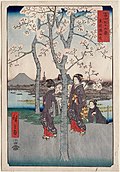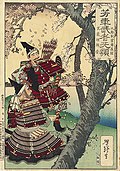Hanami

Hanami (Japanese: 花見) means "flower viewing" in Japanese. Enjoying beautiful flowers is an old Japanese custom. Cherry blossoms are the most popular. The custom of hanami is more than a thousand years old. It is still very popular in Japan. Hanami takes place in the spring. Cherry blossoms are there for only a week or two. The cherry trees flower in late March and early April.[1] The blossoms do not stay fresh very long. After a little time, the blooming is over. Then the blossoms fall from the trees.
An older form of hanami also exists in Japan. It celebrates the plum blossoms, instead of the cherry blossoms.
History

The practice of hanami is many centuries old. It started during the Nara period (710–784) when the Chinese Tang Dynasty influenced Japan in many ways; one of which was the custom of enjoying flowers.[2] Though it was ume blossoms that people admired in the beginning, by the Heian period (794–1185), sakura began to attract more attention. The sakura were considered sacred by the Japanese, and they were so important that they still are a cultural symbol of Japan.[3] People believed in gods' existence inside the trees, and the hanami party was used in the beginning to divine that year's harvest and to announce the season of planting rice. Those who went to the hanami made offerings at the root of sakura trees, and after the ceremony, they took part in the offering drinking sake.[4]
Emperor Saga of the Heian Period adopted this custom, and celebrated parties to view the flowers with sake and feasts under the blossoming branches of sakura trees in the Imperial Court in Kyoto. This was said to be the origin of hanami in Japan.[5] Poems were written praising the delicate flowers, which were seen as a metaphor for life itself; beautiful, but lasting for a very short time. This 'temporary' view of life is very popular in Japanese culture and is usually considered as an admirable form of existence; for example, in the samurai's principle of life ending when it's still beautiful and strong, instead of slowly getting old and weak. The Heian era poets used to write poems about how much easier things would be in Spring without the sakura blossoms, because their existence reminded us that life is very short:
| If there were no cherry blossoms in this world How much more tranquil our hearts would be in Spring. |
||
Ariwara no Narihira (825–880)[6]
| ||
Hanami was used as a term that meant "cherry blossom viewing" for the first time in the Heian era novel Tale of Genji (chapter 8, 花宴 Hana no En, "Under the Cherry Blossoms").[7] From then on, in tanka and in haiku poetry, "flowers" meant "sakura", and the terms "hanami" and "flower party" were only used to mean sakura blossom viewing.[8] At the beginning, the custom was followed only by the Imperial Court, but the samurai nobility also began celebrating it during the Azuchi-Momoyama period (1568–1600). In those years, Toyotomi Hideyoshi gave great hanami parties in Yoshino and Daigo, and the festivity became very popular through all the Japanese society.[9] Shortly after that, farmers began their own custom of climbing nearby mountains in the springtime and having lunch under the blooming cherry trees. This practice, called then as the "spring mountain trip", combined itself with that of the nobles' to form the urban culture of hanami.[10] By the Edo period (1600–1867), all the common people took part in the celebrations, in part because Tokugawa Yoshimune planted areas of cherry blossom trees to encourage this. Under the sakura trees, people had lunch and drank sake in cheerful feasts.[11]
Today
Japanese people continue the tradition of hanami. People fill parks to eat and drink under the flowering trees. In more than half of Japan, the cherry blossoming days come at the same time of the beginning of school and work after vacation, and so welcoming parties are often opened with hanami. Usually, people go to the parks to keep the best places to celebrate hanami with friends, family, and company co-workers many hours before. In many places such as Ueno Park, temporary paper lanterns are hung for night viewing of the flowers.
The blossom forecast or cherry blossom front is announced each year by the Japan Meteorological Agency.[12] The first cherry blossoms happen in the subtropical southern islands of Okinawa, while on the northern island of Hokkaido, they bloom much later. In most large cities like Tokyo, Kyoto and Osaka, the cherry blossom season normally takes place around the end of March and the beginning of April. The television and newspapers closely follow this "cherry blossom front", as it slowly moves from south to north.[13]
Outside Japan

Hanami is also popular outside of Japan. There are hanami celebrations in Korea, Philippines, China, and elsewhere (many other places).[14]
In 1912, Japan gave 3,000 sakura trees to the United States to celebrate the nations' friendship. These trees were planted in Washington, D.C.. 3,800 more trees were added 1956. These sakura trees are a popular tourist attraction. Each year, the National Cherry Blossom Festival happens when they bloom in early Spring.[15]
In Macon, Georgia, another cherry blossom festival called the International Cherry Blossom Festival is celebrated every spring. Macon is known as the "Cherry Blossom Capital of the World" because 300,000 sakura trees grow there.
In Brooklyn, New York, the Annual Sakura Matsuri Cherry Blossom Festival takes place in May at Brooklyn Botanic Garden.[16] This festival started in 1981 and is very popular.
Picture gallery
"Yoshitsune and Benkei Viewing Cherry Blossoms", by artist Tsukioka Yoshitoshi, 1885
Hanami party at Odawara Castle.
Sakura trees with paper lanterns in Tokyo.
Sakura trees in Washington, D.C.
International Cherry Blossom Festival in Macon, Georgia, United States.
Hanami Media
'Shidare-zakura' is the first recorded cultivar in Japan.
The Jindai-zakura, a tree which is about 2,000 years old
'Kanzan' is a double-flowered cultivar developed in the Edo period. It has 20 to 50 petals in a flower.
Yoshino cherry ('Somei-yoshino') has rapidly spread throughout Japan since the Meiji period.
Cherry blossom at Kirsikkapuisto in Helsinki, Finland
(video) Hanami picknickers in Bunkyō, 2015
Related pages
References
- ↑ ""A beginner's guide to Hanami" → How long do they bloom?". Japan-guide.com. Retrieved June 20, 2012.; excerpt, "Full bloom (満開, mankai) is usually reached within about one week after the opening of the first blossoms (開花, kaika)."
- ↑ Varley, H. Paul. (2000). Japanese Culture (4th ed.). University of Hawaii Press. pp. 73–74. ISBN 978-0-8248-2152-4.
- ↑ Akasegawa, Gempei (2000). Sennin no sakura, zokujin no sakura: Nippon kaibo kiko (in Japanese). JTB Nihon Kotsu Kosha Shuppan Jigyokyoku. ISBN 978-4-533-01983-8.
{{cite book}}: CS1 maint: unrecognized language (link) Cited at Cyber Sakura Watching Archived 2007-04-28 at the Wayback Machine, Osaka Seikei University, Kyoto, Japan. - ↑ Varley, p. 74.
- ↑ Varley, pp 75–78.
- ↑ "Cherry Blossom Viewing". Japan Mint. Archived from the original on May 23, 2007. Retrieved August 14, 2007.
- ↑ Shikibu, Murasaki; Tyler, Royall (2006). The Tale of Genji. Penguin Classics. pp. 86–87. ISBN 0-14-303949-0.
- ↑ Tetsuya, Ito. "Genji Monogatari" (in Japanese). The Japanese Literature Project online. Archived from the original on August 24, 2007. Retrieved August 15, 2007.
{{cite web}}: CS1 maint: unrecognized language (link) - ↑ Varley, pp. 75–79.
- ↑ Varley, p. 79.
- ↑ Varley, pp. 79–80;"MIT Japanese: Culture notes - Ohanami". Massachusetts Institute of Technology, Cambridge, Massachusetts. Retrieved August 17, 2007.
- ↑ "Japanese Culture - Calendar - Hanami Season". JapanZone. Retrieved August 15, 2007.
- ↑ Akasegawa, Gempei (2000). Sennin no sakura, zokujin no sakura: Nippon kaibo kiko (in Japanese). JTB Nihon Kotsu Kosha Shuppan Jigyokyoku. ISBN 978-4-533-01983-8.
As cherry blossom front comes up, the whole Japan goes into a war; we just can't sit home and let it go
{{cite book}}: CS1 maint: unrecognized language (link) Cited at Cyber Sakura Watching Archived 2007-04-28 at the Wayback Machine, Osaka Seikei University, Kyoto, Japan - ↑ "Spring flower festival events". Seoul Metropolitan Government. Archived from the original on May 25, 2009. Retrieved August 18, 2007.
- ↑ "National Cherry Blossom Festival". Official Site. Retrieved August 16, 2007.
- ↑ "Brooklyn Botanic Garden Celebrates Hanami". Brooklyn Botanic Garden, Brooklyn, New York. Archived from the original on August 8, 2007. Retrieved August 17, 2007.
Other websites
| Wikimedia Commons has media related to Lua error in Module:Commons_link at line 62: attempt to index field 'wikibase' (a nil value).. |
![]()
- Hanami Fun Facts Archived 2012-03-27 at the Wayback Machine—Japanzine: Field Guide to Japan by Zack Davisson
- Hanami Manners 101 Archived 2012-02-05 at the Wayback Machine—Japanzine by Emily Millar
- Cherry Blossom Viewing: Japan Mint Archived 2007-05-23 at the Wayback Machine
- Hanami - Cherry Blossom Viewing in Japan
- Seasons In Japan - Cherry Blossoms (sakura)—Japan Visitor
















